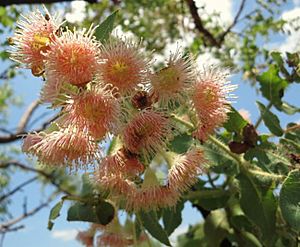Dunlop's bloodwood facts for kids
Quick facts for kids Dunlop's bloodwood |
|
|---|---|
 |
|
| Corymbia dunlopiana near Edith Falls | |
| Scientific classification | |
| Genus: |
Corymbia
|
| Species: |
dunlopiana
|
| Synonyms | |
|
Eucalyptus dunlopiana (K.D.Hill & L.A.S.Johnson) Brooker |
|
Corymbia dunlopiana, also known as Dunlop's bloodwood, bongonyin, or Oenpelli bloodwood, is a special type of tree. It grows only in the Northern Territory of Australia. This tree has rough bark on its trunk and branches. It also has unique leaves, red flowers, and fruit shaped like an urn.
Contents
What Does Dunlop's Bloodwood Look Like?
Corymbia dunlopiana is a tree that usually grows up to 7 meters (about 23 feet) tall. It often has branches that are twisted and not perfectly straight. The bark is rough and can be flaky or look like a puzzle. It's usually grey-brown over a reddish-brown color.
Leaves and Branches
The small branches, leaves, and flower buds of this tree are all rough and hairy. Young plants and new shoots have heart-shaped or oval leaves. These leaves are 40 to 125 millimeters (about 1.5 to 5 inches) long and 30 to 80 millimeters (about 1 to 3 inches) wide. They have a rounded base or one that wraps around the stem.
The top part of the tree, called the crown, only has these young leaves. They are attached directly to the stem without a stalk. These leaves are heart-shaped, lance-shaped, or oblong. They measure 35 to 120 millimeters (about 1.4 to 4.7 inches) long and 20 to 57 millimeters (about 0.8 to 2.2 inches) wide. They grow in pairs opposite each other. Both sides of the leaves are a dull yellow-green, light green, or grey-green color.
Flowers and Fruit
The flower buds grow in the leaf axils (the angle between a leaf and the stem). They can also be found at the ends of the branches. They grow on a branched stalk called a peduncle, which is up to 4 millimeters long. Each part of the peduncle can have one, three, or sometimes seven buds. These buds are on smaller stalks called pedicels, which are 4 to 35 millimeters long.
When the buds are ready, they are pear-shaped. They are 12 to 20 millimeters (about 0.5 to 0.8 inches) long and 7 to 10 millimeters (about 0.3 to 0.4 inches) wide. They have a beak-like cap called an operculum. You can see these trees flowering in most months of the year. However, they bloom most often from the end of the dry season into the beginning of the wet season.
How Dunlop's Bloodwood Got Its Name
The scientific name Corymbia dunlopiana was first officially described in 1995. This was done by two botanists, Ken Hill and Lawrie Johnson. They studied samples of the tree collected near Pine Creek in 1985.
The second part of the name, dunlopiana, honors a botanist from the Northern Territory named Clyde R. Dunlop. The local Wagiman people call this tree "Bongonyin."
Where Does Dunlop's Bloodwood Grow?
You can find Corymbia dunlopiana in the Northern Territory of Australia. Its range stretches from west of Katherine to the Daly River. It also grows as far east as near Jim Jim.
This tree usually grows in open savannah woodlands. It prefers higher ground, rocky areas, and ridges. The soil in these places is often thin and rocky. Sometimes, you can find whole groups of these trees growing together. They often look like small, twisted shrubs.

